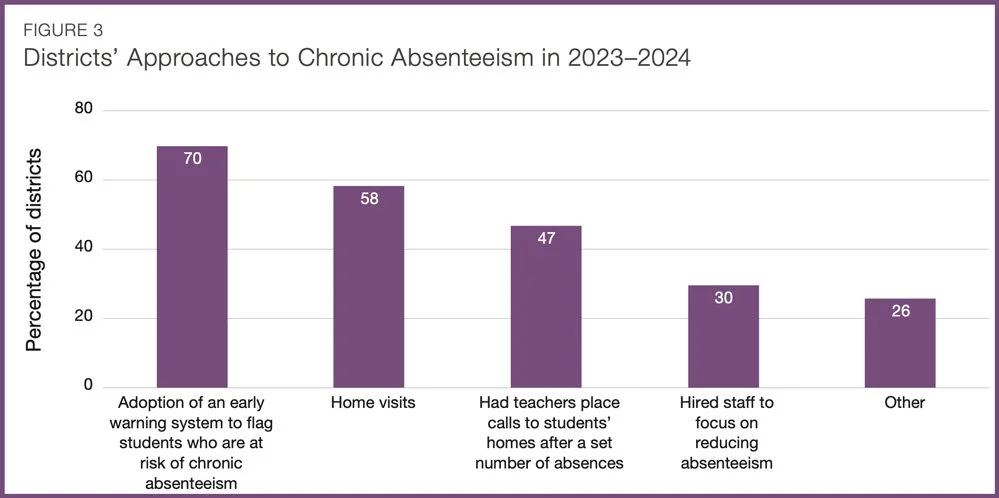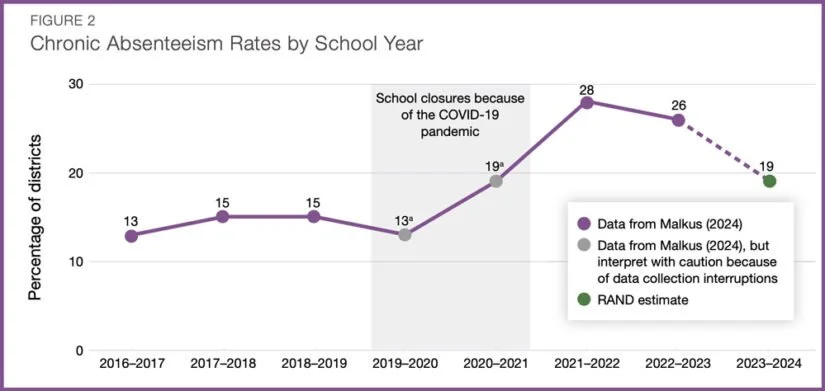Report: Parental ‘Apathy’ Blamed for Rise in Chronic Absenteeism
Image by Eamonn Fitzmaurice/The 74
This story was produced by The 74, a non-profit, independent news organization focused on education in America.
A quarter of district leaders in a recent survey said chronic absenteeism has gotten so bad that none of their strategies are working, a problem some attribute to increased parental “apathy” about the importance of school since the pandemic.
Most districts try to prevent chronic absenteeism through early warning systems that identify students who miss too much school, according to the report by the Rand Corp. Districts also conduct home visits, call families when students are out and hire staff who specifically address attendance.
Researchers asked district leaders about four strategies for reducing chronic absenteeism. Creating an early warning system was the most common, but no method was considered the most effective. (Image by Rand Corp.)
But those efforts meet with pushback from parents. Some say, for example, that letters sent home nudging students to attend school are “too harsh.”
“Parents’ overall feelings about the importance of school have changed,” said Jessica Hull, executive director of communication and community engagement for the Roseville City School District, outside Sacramento. Chronic absenteeism in the district has dropped from its pandemic high point of 26% to 11%, but that is still roughly double its pre-COVID rate.
Some students with family members outside of the U.S. can be gone for weeks at a time. Others frequently miss Fridays and Mondays, while some older children are tasked with caring for younger siblings.
“I’m generally a very positive person,” Hull said. “But I don’t know that we’ll really dramatically change those things.”
The report comes as more states are showing leadership on the issue. On Monday, Attendance Works, an advocacy and research organization, announced that 14 states have committed to cutting chronic absenteeism in half over five years in response to a challenge it issued in July along with the American Enterprise Institute and EdTrust. Chronic absenteeism peaked at 28% nationally in the 2021-22 school year. The Rand survey of nearly 200 district leaders estimates that rates dropped to about 19% last school year, but that’s still above the pre-COVID level of 15%.
In a statement, Hedy Chang, executive director of Attendance Works, said states are “uniquely positioned to alert everyone to the size of this challenge.”
But the Rand report suggests district leaders feel a sense of urgency to reach families with children who miss the most school now.
“The leaders we interviewed were frustrated because there are chronically absent students for whom their interventions aren’t working,” said Lydia Rainey, a researcher with the
Center on Reinventing Public Education, which collaborated with Rand on the survey. “Some of the leaders had ideas for new programs to try; others were at a loss for what to do next. No one talked about giving up.”
The authors urged districts to emphasize approaches that foster stronger relationships between students and staff — an ingredient that even discouraged leaders say is the key to more successful strategies. Parents need to understand how poor attendance impacts their children’s academic performance, researchers said, and districts should collect better evidence on which methods make students want to come to school.
The U.S. Department of Education last week encouraged similar strategies in new guidance for low-performing schools identified as part of states’ accountability systems. The public has until Oct. 4 to provide comments on the draft. In addition, a recently posted fact sheet from the Department of Transportation offers other ideas, like teaching students to ride bikes if transportation is unavailable.
The Rand Corp. and Center on Reinventing Public Education survey estimates that chronic absenteeism dropped to 19% during the 2023-24 school year. That’s still higher than the pre-pandemic rate of 15%. (Image by Rand Corp.)
In its effort to address the problem, the Roseville City district supplies gas cards to families who can’t afford to fill up and encourages transient and homeless families to transfer schools if their living situations have changed.
“One school that works at the beginning of the year might not be the school that works at the end of the year,” Hull said.
Lines of communication
School leaders sometimes modify district-level practices to keep the connections with parents positive.
In central Wyoming’s Fremont County district, for example, home-to-school liaisons call families when students miss too much school. But Katie Law, principal of Arapahoe Charter High School in the district, changed the title for these liaisons to student advocate — “so families see that it is an attempt to help.”
To comply with state laws and tribal codes, the district also sends letters and truancy citations to families of chronically absent students. But Law said those messages are often counterproductive.
“This just made relationships and trust between the school and the parents worse and led to students dropping out entirely,” she said. “It wasn’t effective.”
Law has tried some of the conventional strategies Rand studied, but she has also added some home-grown ideas, like handing out prepaid phone cards so she can text students when they’re not in class.
“We can open those lines of communication instead of trying to find four different phone numbers that might be disconnected,” she said.
A monthly “community day” is one of the strategies Arapahoe Charter High School, in Wyoming’s Fremont County district, uses to reduce chronic absenteeism. (Photo by Katie Law)
Food is another incentive. Once a month, the school holds a community day, including a “giant potluck.” Last week, students and staff made pancakes and volunteered at the local food bank.
“Kids start to feel that somebody’s depending on them the way they depend on other people,” Law said. “It shows them that accountability.”
‘Tricky’ questions
That mixture of approaches demonstrates how schools can connect with students socially. The “next phase” is ensuring families see an academic payoff as well, said Liz Cohen, policy director at FutureEd, a research center at Georgetown University. She recently examined a statewide effort to reduce chronic absenteeism in Rhode Island.
“Do students, especially high school students, feel that going to school has value? Is it a good use of their time?” she asked. “We have to start tackling the tricky and sticky questions of what happens within the school day, academically, that makes it worth it for students to stay in those buildings.”
As part of the Rhode Island effort, the state posts data showing how chronic absenteeism affects the percentage of students meeting math and reading expectations. The state also operates a Student Attendance Leaderboard that is updated every night and gives the public a real-time picture of absenteeism rates.
The Rhode Island Department of Education compares achievement data by chronic absenteeism rates to help the public understand how missing too much school affects learning. (Image by FutureEd)
This year’s data is promising, with the rate declining from almost 29% in 2022-23 to less than 25%.
Nearby Connecticut, which publishes monthly reports on chronic absenteeism at the district and school level, has seen a decline from 20% in 2022-23 to 17.7%.
But few states offer such timely, localized data, and most don’t even release statewide figures until October or later.
That’s part of the problem, Cohen said.
“This should be unacceptable,” she said, “given the agreement on how urgent this problem is.”
Linda Jacobson is a senior writer at The 74.






